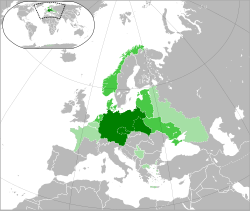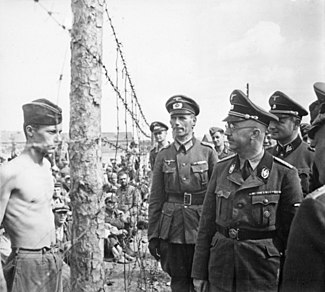
Nazi Germany, officially known as the German Reich and later the Greater German Reich, is a term used to describe the German state between 1933 and 1945, when Adolf Hitler and the Nazi Party controlled the country, transforming it into a totalitarian dictatorship. The Third Reich, meaning "Third Realm" or "Third Empire", referred to the Nazi claim that Nazi Germany was the successor to the earlier Holy Roman Empire (800–1806) and German Empire (1871–1918). The Third Reich, which the Nazis referred to as the Thousand-Year Reich, ended in May 1945, after only 12 years, when the Allies defeated Germany and entered the capital, Berlin, ending World War II in Europe.

The Axis powers, originally called the Rome–Berlin Axis and also Rome–Berlin–Tokyo Axis, was a military coalition that initiated World War II and fought against the Allies. Its principal members were Nazi Germany, the Kingdom of Italy and the Empire of Japan. The Axis were united in their far-right positions and general opposition to the Allies, but otherwise lacked comparable coordination and ideological cohesion.

Nacht und Nebel, meaning Night and Fog, also known as the Night and Fog Decree, was a directive issued by Adolf Hitler on 7 December 1941 targeting political activists and resistance "helpers" in the territories occupied by Nazi Germany during World War II, who were to be imprisoned, murdered, or made to disappear, while the family and the population remained uncertain as to the fate or whereabouts of the alleged offender against the Nazi occupation power. Victims who disappeared in these clandestine actions were often never heard from again.

Arthur Seyss-Inquart was an Austrian Nazi politician who served as Chancellor of Austria in 1938 for two days before the Anschluss. His positions in Nazi Germany included deputy governor to Hans Frank in the General Government of Occupied Poland, and Reich commissioner for the German-occupied Netherlands. In the latter role, he shared responsibility for the deportation of Dutch Jews and the shooting of hostages.
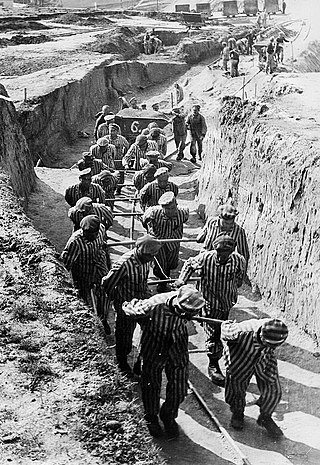
From 1933 to 1945, Nazi Germany operated more than a thousand concentration camps, including subcamps on its own territory and in parts of German-occupied Europe.

Kurt Alois Josef Johann von Schuschnigg was an Austrian politician who was the Chancellor of the Federal State of Austria from the 1934 assassination of his predecessor Engelbert Dollfuss until the 1938 Anschluss with Nazi Germany. Although Schuschnigg considered Austria a "German state" and Austrians to be Germans, he was strongly opposed to Adolf Hitler's goal to absorb Austria into the Third Reich and wished for it to remain independent.
The Austrian resistance launched in response to the rise of the fascists across Europe and, more specifically, to the Anschluss in 1938 and resulting occupation of Austria by Germany.
Holocaust victims were people targeted by the government of Nazi Germany based on their ethnicity, religion, political beliefs, disability or sexual orientation. The institutionalized practice by the Nazis of singling out and persecuting people resulted in the Holocaust, which began with legalized social discrimination against specific groups, involuntary hospitalization, euthanasia, and forced sterilization of persons considered physically or mentally unfit for society. The vast majority of the Nazi regime's victims were Jews, Sinti-Roma peoples, and Slavs but victims also encompassed people identified as social outsiders in the Nazi worldview, such as homosexuals, and political enemies. Nazi persecution escalated during World War II and included: non-judicial incarceration, confiscation of property, forced labor, sexual slavery, death through overwork, human experimentation, undernourishment, and execution through a variety of methods. For specified groups like the Jews, genocide was the Nazis' primary goal.

Austria was part of Nazi Germany from 13 March 1938 until 27 April 1945, when Allied-occupied Austria declared independence from Nazi Germany.

The Fatherland Front was the right-wing conservative, nationalist and corporatist ruling political organisation of the Federal State of Austria. It claimed to be a nonpartisan movement, and aimed to unite all the people of Austria, overcoming political and social divisions. Established on 20 May 1933 by Christian Social Chancellor Engelbert Dollfuss as the only legally permitted party in the country, it was organised along the lines of Italian Fascism, was fully aligned with the Catholic Church, and did not advocate any racial ideology, as Italian Fascism later did. It advocated Austrian nationalism and independence from Germany on the basis of protecting Austria's Catholic religious identity from what they considered a Protestant-dominated German state.

The use of slave and forced labour in Nazi Germany and throughout German-occupied Europe during World War II took place on an unprecedented scale. It was a vital part of the German economic exploitation of conquered territories. It also contributed to the mass extermination of populations in occupied Europe. The Germans abducted approximately 12 million people from almost twenty European countries; about two thirds came from Central Europe and Eastern Europe. Many workers died as a result of their living conditions – extreme mistreatment, severe malnutrition and abuse were the main causes of death. Many more became civilian casualties from enemy (Allied) bombing and shelling of their workplaces throughout the war. At the peak of the program the forced labourers constituted 20% of the German work force. Counting deaths and turnover, about 15 million men and women were forced labourers at one point during the war.
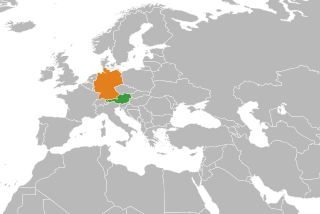
Relations between Austria and Germany are close due to their shared history and culture, with German being the official language and Germans being the major ethnic group of both countries.

Fascist movements in Europe were the set of various fascist ideologies which were practiced by governments and political organizations in Europe during the 20th century. Fascism was born in Italy following World War I, and other fascist movements, influenced by Italian Fascism, subsequently emerged across Europe. Among the political doctrines which are identified as ideological origins of fascism in Europe are the combining of a traditional national unity and revolutionary anti-democratic rhetoric which was espoused by the integral nationalist Charles Maurras and the revolutionary syndicalist Georges Sorel.
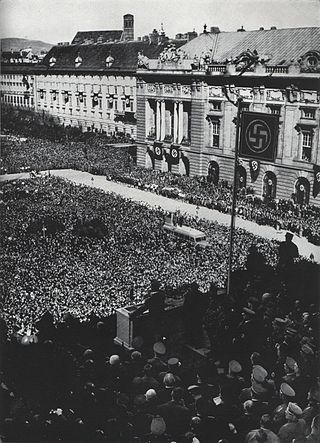
The Anschluss, also known as the Anschluß Österreichs, was the annexation of the Federal State of Austria into the German Reich on 13 March 1938.

The July Putsch was a failed coup attempt against the Austrofascist regime by Austrian Nazis from 25 to 30 July 1934.
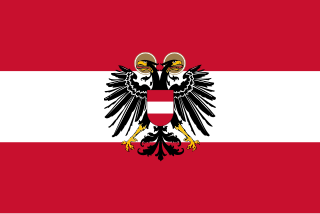
The Federal State of Austria was a continuation of the First Austrian Republic between 1934 and 1938 when it was a one-party state led by the conservative, nationalist, and corporatist Fatherland Front. The Ständestaat concept, derived from the notion of Stände, was advocated by leading regime politicians such as Engelbert Dollfuss and Kurt Schuschnigg. The result was an authoritarian government based on a mix of Italian Fascist and conservative Catholic influences.

Prince Ernst Rüdiger Camillo von Starhemberg, often known simply as Prince Starhemberg, was an Austrian nationalist and politician who helped introduce Austrofascism and install a clerical fascist dictatorship in Austria in the interwar period. A fierce opponent of Anschluss, he fled Austria when the Nazis invaded the country and briefly served with the Free French and British forces in World War II.
The foreign relations of Third Reich were characterized by the territorial expansionist ambitions of Germany's dictator Adolf Hitler and the promotion of the ideologies of anti-communism and antisemitism within Germany and its conquered territories. The Nazi regime oversaw Germany's rise as a militarist world power from the state of humiliation and disempowerment it had experienced following its defeat in World War I. From the late 1930s to its defeat in 1945, Germany was the most formidable of the Axis powers - a military alliance between Imperial Japan, Fascist Italy, and their allies and puppet states. Adolph Hitler made most of the major diplomatic policy decisions, while foreign minister Konstantin von Neurath handled routine business.

Between 1933 and 1945, a large number of Jews emigrated from Nazi Germany and German-occupied Europe. This exodus was triggered by the militaristic antisemitism perpetrated by the Nazi Party and by Germany's collaborators, ultimately culminating in the Holocaust. However, even before the genocide itself, which began during World War II, the Nazis had widely sponsored or enforced discriminatory practices—by legislation, in many cases—against Jewish residents, such as through the Nazi boycott of Jewish-owned businesses. Although Adolf Hitler and the German government were initially accepting of voluntary Jewish emigration from the country, it became difficult to find new host countries, particularly as the 1930s were marked by the Great Depression, as the number of Jewish migrants increased. Eventually, the Nazis forbade emigration; the Jews who remained in Germany or in German-occupied territory by this point were either murdered in the ghettos or relocated to be systematically exploited and murdered at dedicated concentration camps and extermination camps throughout the European continent.

The victim theory, encapsulated in the slogan "Austria – the Nazis' first victim", was the 1949–1988 Austrian ideological basis formed by Austrians themselves under Allied occupation and independent Second Austrian Republic. According to the founders of the Second Austrian Republic, the 1938 Anschluss was an act of military aggression by the Third Reich. Austrian statehood had been interrupted and therefore the newly revived Austria of 1945 could not and should not be considered responsible for the Nazis' crimes in any way. The "victim theory" that had formed by 1949 insisted that all of the Austrians, including those who strongly supported Hitler, had been unwilling victims of the Nazi regime and were therefore not responsible for its crimes.



